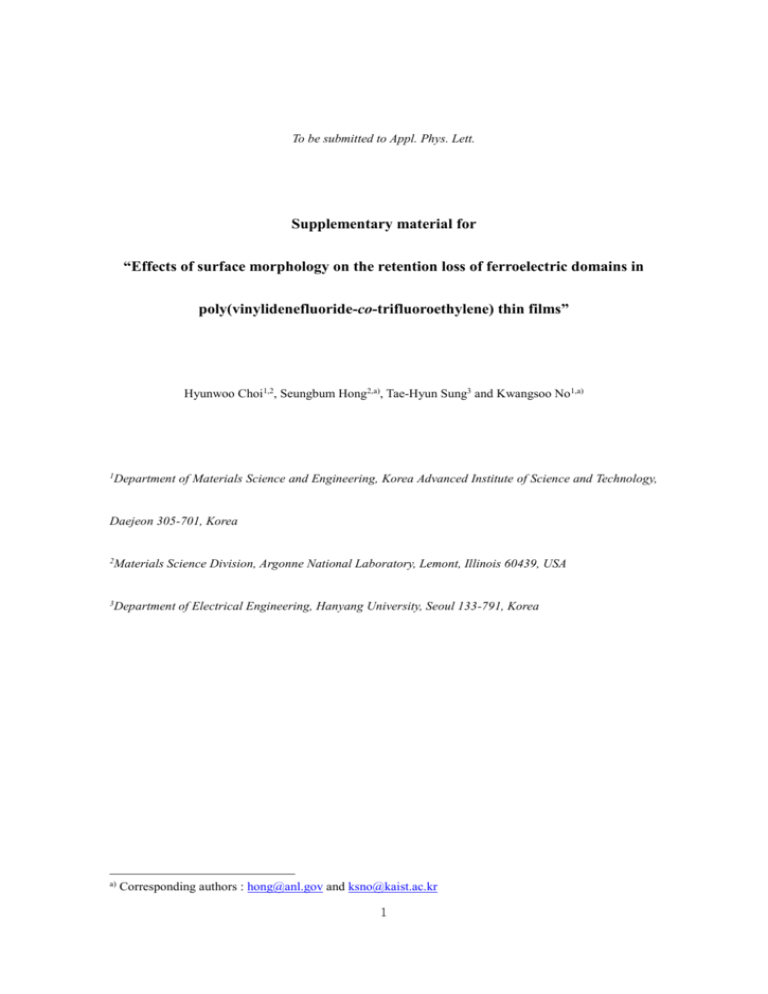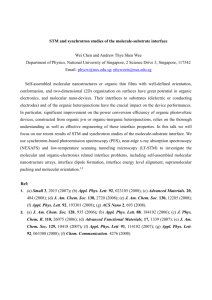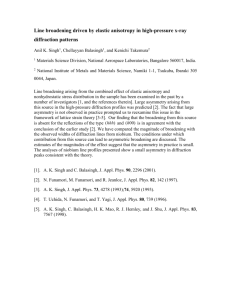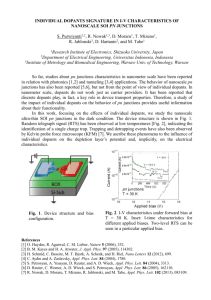Investigations of retention properties of PbTiO3
advertisement

To be submitted to Appl. Phys. Lett. Supplementary material for “Effects of surface morphology on the retention loss of ferroelectric domains in poly(vinylidenefluoride-co-trifluoroethylene) thin films” Hyunwoo Choi1,2, Seungbum Hong2,a), Tae-Hyun Sung3 and Kwangsoo No1,a) 1 Department of Materials Science and Engineering, Korea Advanced Institute of Science and Technology, Daejeon 305-701, Korea 2 Materials Science Division, Argonne National Laboratory, Lemont, Illinois 60439, USA 3 Department of Electrical Engineering, Hanyang University, Seoul 133-791, Korea a) Corresponding authors : hong@anl.gov and ksno@kaist.ac.kr 1 Topography, PFM phase and amplitude images of ferroelectric domains in P(VDFTrFE) thin film Figure S1 shows the topography, PFM phase and amplitude images of a square domain on a P(VDF-TrFE) thin film. A green square in the topography image indicates the position of the square domain. Positively (negatively) poled region shows dark (bright) contrast with downward (upward) polarization, which is opposite to the contrast observed in ferroelectric oxides.1,2 This incongruity is attributed to the fact that the piezoelectric constant of P(VDF-TrFE) have an opposite sign to that of the ferroelectric oxides.3,4 Figure S1. Topography, PFM phase and amplitude images of a square domain. A green square in the topography image indicates the position of the square domains. The black scale bar presents 500 nm. 2 Calculation of morphological gradients Figure S2 shows the morphological gradients of all regions in the square domains with ascending order (inset image indicates the position of all sites whose morphological gradients were worked out). We obtained the line profiles of the straight sections across the nucleation points of the opposite domains (see lower parts in figure 2), followed by the calculation of the tangential gradient values by dividing of y-axis increment by x-axis increment. It is worth noting that the straight sections for the morphological gradient were drawn along the directions which result in the largest gradient value. The full range of the morphological gradients was between 0.061 and 0.393, and the gradients range of the domain reversal was between 0.079 and 0.146. 3 Figure S2. Morphological gradients of all regions in the square domains with ascending order. Blue bars indicate the regions where the opposite domain nucleated and the other regions are represented by red bars. Inset image shows the positions of all places which their morphological gradients were calculated corresponding to the square domains. Blue dots in the inset image indicate the nucleation points of the opposite domains. The black scale bar in the inset image presents 200 nm. 4 Retention property of P(VDF-TrFE) thin films Figure S3 shows the normalized size of the square domains as a function of lapsed time. It can be seen that the retention loss trends are well fitted to the stretched exponential relaxation behavior (stretched exponential factor n is less than one), which suggest that the loss occurs by random walk process, which describes a sequence of unpredictable switching obeying a set of prescribed rules detailed below.5 Stretched exponential relaxation phenomena, observed in disordered systems and describing the relaxation of polarizations towards equilibrium and dispersive diffusion, is expressed by the power-law time dependence exp[-(t/τ)n], where 0<n<1. This phenomenon can be explained by the continuous random walk process, which is non-stationary and its variance increases with time. Stretched exponential factor n and the relaxation time constant τ were 0.16 and 5.9 × 1011 sec, respectively. In addition, the area of the domain decreased to about 80 % of its initial state after 2.35 × 106 sec. P(VDF-TrFE) thin films show not only considerably low n and large τ, but also high remained domain fraction per totally lapsed time, which is superior to those of ferroelectric oxide thin films (see Table SI). 5 Figure S3. Normalized size of the square domains as a function of lapsed time. 6 Table SI. Stretched exponential factor n, time constant τ, remained domain fraction (RDF) and totally lapsed time (LT) of previously reported oxide and P(VDF-TrFE) thin films. n τ RDF LT (a. u.) (sec) (%) (sec) 88 2 × 105 20 2.5 × 104 Materials a Pb(Zr0.2Ti0.8)O3 b Pb(Zr0.3Ti0.7)O3 0.31 1.03 × 104 c Pb(Zr0.4Ti0.6)O3 0.25 5 × 1011 d BiFeO3 0.483 2.27 × 106 89 3 × 104 0.295 2.85 × 106 80 3 × 104 0.246 8.54 × 106 77.5 3 × 104 e PbTiO3 1.23 2.4 × 103 80 6 × 103 f Pb(Zr0.3Ti0.7)O3 0.42 1.26 × 105 40 3 × 105 0.16 5.9 × 1011 80 2.35 × 106 P(VDF-TrFE) a Reference 6. b Reference 7. c Reference 8. d Reference 9. 7 e Reference 10. f Reference 11. Reference 1 Y. Kim, W. Kim, H. Choi, S. Hong, H. Ko, H. Lee and K. No, Appl. Phys. Lett. 96, 012908 (2010) 2 Y. Kim, S. Buhlmann, S. Hong, S. H. Kim and K. No, Appl. Phys. Lett. 90, 072910 (2007) 3 K. Noda, K. Ishida, A. Kubono, T. Horiuchi, H. Yamada and K. Matsushige, Jpn. J. Appl. Phys. 39, 6358 (2000) 4 A. V. Bune, C. Zhu, S. Duchame, L. M. Blinov, V. M. Fridkin, S. P. Palto, N. G. Pethkhova and S. G. Yudin, J. Appl. Phys. 85, 7869 (1999) 5 A. Gruverman, H. Tokumoto, A. S. Prakash, S. Aggarwal, B. Yang, M. Wuttig, R. Ramesh, O. Auciello and T. Venkatesan, Appl. Phys. Lett. 71, 3492 (1997) 6 C. S. Ganpule, A. L. Roytburd, V. Nagarajan, B. K. Hill, S. B. Ogale, E. D. Williams and R. Ramesh, Phys. Rev. B 65, 014101 (2001) 7 D. Fu, K. Suzuki, K. Kato and H. Suzuki, Appl. Phys. Lett. 82, 2130 (2003) 8 V. Nagarajan, S. Aggarwal, A. Gruverman, R. Ramesh and R. Waser, Appl. Phys. Lett. 86, 262910 (2005) 9 10 C. C. Lee and J. M. Wu, Appl. Phys. Lett. 91, 102906 (2007) A. Morelli, S. Venkatesan, G. Palasantzas, B. J. Kooi and J. Th. M. De Hosson, J. Appl. Phys. 102, 084103 (2007) 8 11 D. Fu, K. Suzuki, K. Kato, M. Minakata and H. Suzuki, Jpn. J. Appl. Phys. 41, 6724 (2002) 9






